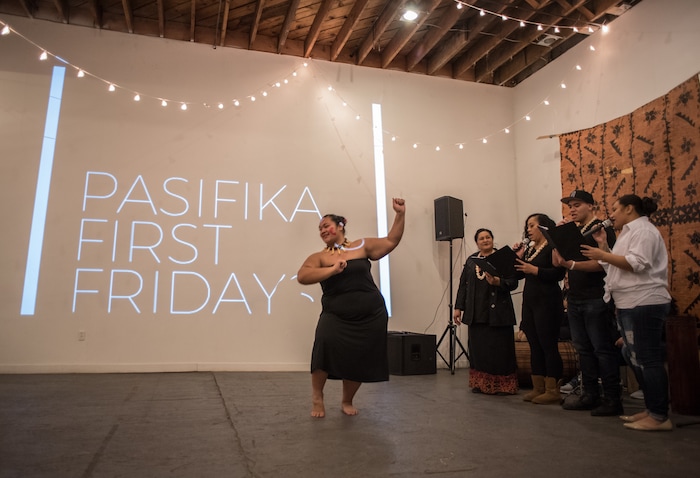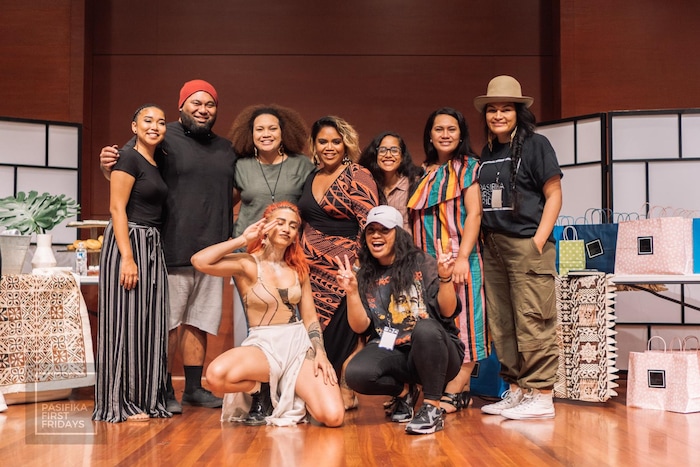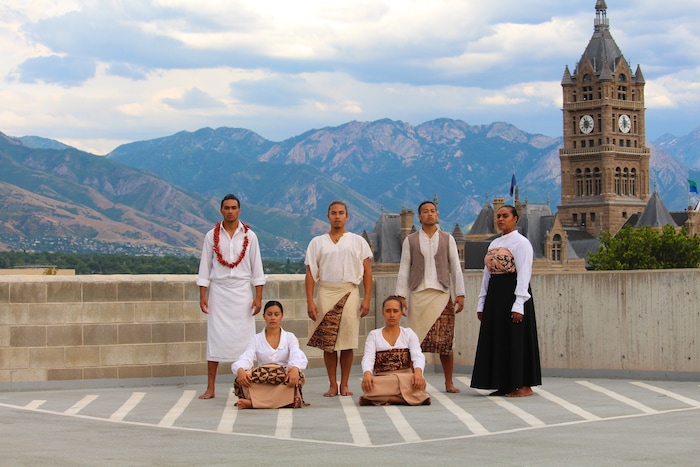Ancestors of Pacific Islanders sailed across the open waters of the Pacific on boats lashed together, navigating by the stars, the moon, the sun and cloud formations. They were scientists, artists and storytellers, but much of their history remains unknown off the islands — partly because there have been few spaces for their culture to be shared.
A roving pop-up art festival seeks to change that for modern Pacific Islanders in Utah. Pasifika First Fridays is held the first Friday of every month, inside empty storefronts at The Gateway in Salt Lake City and other locations throughout the Salt Lake Valley.
Past events have included music, spoken-word performances, contemporary dance, live art shows and an international film festival, with all content originating from within the Pasifika community.
“There’s a disconnect because we don’t have an ocean,” said Moana Palelei HoChing, creative director of Pasifika First Fridays. But “your art form, your science, your way of thinking, your culture isn’t only designated to the Pacific. It travels.”
She designs and organizes Pasifika First Fridays with her siblings Malia Taula, Mallory Palelei and Monique HoChing; the four Samoan sisters from Sandy run the business together. On March’s first Friday they marked the festival’s second anniversary with a celebration at The Gateway and the release of their online magazine Archive, and they hope to draw more Utahns to their events in their third year.
“For me personally, I want to get more crowds, different crowds … different art scenes, different backgrounds,” said Monique HoChing, the festival’s curator. “I think that’ll make the [Pasifika First Fridays] spaces even better, just a big collection of everything that Utah has to offer.”
The festival has its 2020 monthly programs scheduled out until December, including a live-art show with returning painter Aljay Fuimaono in May, Pasifika Pride Prom in June and a plus-size fashion show in August, with a casting call for plus-size models scheduled on March 14.
The Salt Lake City area is home to one of the largest Pacific Islander communities in the contiguous United States, due in large part to missionary work by The Church of Jesus Christ of Latter-day Saints.
Moana Palelei HoChing first heard about First Friday events when she was attending Harvard and living in Boston, where some museums would close early but then open up gatherings at night. She realized the programs were about equity and providing spaces for those who wouldn’t have them otherwise, she said.
There are other First Fridays around the country that the sisters also used as a model. The initial idea for a similar series in Utah developed as they “were just talking about how growing up, we didn’t really see spaces outside of a football stadium that you could gather,” said Taula, Pasifika’s community director.
“One of the main goals of Pasifika First Fridays, for me personally, is to learn, remember and honor my heritage and culture,” Monique HoChing added in an email. “The driving force behind us setting up every month is our kids/nieces/nephews (we have nine of them). We hope PFF can instill pride in them for their PI heritage and Utah home.”
‘The power of art’
Pasifika First Fridays’ launch party was in March 2018 at Ember, an event venue in a 100-year-old urban space on State Street in downtown Salt Lake City, and it featured Malielole, a family performing group from Glendale.
As word spread about the events, the Smithsonian Asian Pacific American Center reached out to collaborate on a spoken word production that summer. Poets from other states and various Pacific Island heritages came together for the Pasifika of Utah Poetry Slam at the Utah Museum of Fine Arts.
The festival also brought in Le Moana, a contemporary dance troupe from New Zealand. During its performance of “1918,” about the Spanish Influenza outbreak that killed a fourth of the population of the Pacific Islands, “there was not a dry eye in the room,” Moana Palelei HoChing said.
“The power of art is to move people who don’t necessarily identify with that community but understand the hurt and understand the victory,” she said. She also serves on a Salt Lake County advisory board that oversees funding for large arts organizations from the Zoo, Arts and Parks sales tax.
Le Moana will return to Utah to do a Pasifika show in September, as the festival strives to connect Utah with Pacific Island artists from around the world.
The HoChing sisters said they also aim to work with stakeholders who view the state’s growing Pacific Islander community as an equal partner and want to see its members thrive. They often get requests to send an artist to an event, particularly in August during Pacific Islander Heritage Month.
“I don’t want our artists to go into a space and feel used or feel like their art isn’t taken seriously because they’re only there for the Heritage Month,” said Monique HoChing.
She is a student at the University of Utah and currently serves as the vice president of the Art History Student Association. More community voices need to be heard throughout these organizations, she said. “The trend is they have to adapt or die,” she said of museums. “You know, how are you guys fashioning your programming or even your space to really accommodate a community to come in?”
The University of Utah received a $600,000 grant from the Andrew W. Mellon Foundation for its Pacific Islands Studies initiative in 2018, and the sisters have been advocating for the school to help build a Pacific Art Institute in Salt Lake City. They want to make sure funds are being used in a way that is most beneficial to the Pasifika community in Utah.
“An institute would be a main goal of ours,” Taula said. “That way we could house a lot more kids that want to get into this. Or just be creative and show their work and have the resources available.”
In their current passion project, Lost Eden, they envision taking over cement pads in disenfranchised neighborhoods to create micro-commercial spaces where people can sell art and gather to talk about culture and community.
“Culture matters,” said Moana Palelei HoChing. “... But I’m not just saying [Pacific Island] culture. … What does it feel like to grow up here in Salt Lake City? What does it feel like to live off island but feel like you’re on an island here?”
‘People believe in me’
Reina Kapiolani Pahulu, who moved to Utah four years ago from California, credits the festival for giving her the courage and a platform to share her poetry publicly for the first time. She was invited to debut her work and co-headlined the Pride Prom, a Pacific LGBQTIA+ friendly dance that Pasifika organizes every summer.
“That’s really all it took, was just having people believe in me,” Pahulu said. “Having people believe in me and then eventually internalizing that and believing in myself.”
She’s now working toward self-publishing a book of poetry and will be doing more readings at Pasifika events. She has started a Pacific Islanders women writers group and has collaborated on other projects through the festival.
“They never charge for the events. That tells you right off the bat it’s about accessibility and making sure that anyone within the community who’s interested can access it,” Pahulu said.
Fuimaono, the artist scheduled to return to Pasifika in May, paints Polynesian people and culture through abstract realism, with works filled with texture and Polynesian symbolism. His latest piece is an intimate painting of two Maori elders in a hongi, where two people greet and put their forehead and noses together and share the same breath. This painting represents unity of cultures, villages and of families, he said.
Originally from Samoa, he learned about other Pacific Islander cultures while attending Brigham Young University-Hawaii, where he had friends from different islands. He specializes in bringing the communities together in his paintings.
In May, his theme will be bringing art to life — allowing people to experience both the artwork itself and the objects he is painting. He will paint Polynesian dancers before their performance, and guests can feel the textures of their clothing, which will be on display. There will also be a traditional Polynesian feast with paintings of the Polynesian dishes.
“They’re going to be eating those foods, so it’s like they’re eating the painting,” said Fuimaono. “It’s like the art piece is coming to life.”
He will share the space with his daughter, who is almost 10 and and will be debuting her ocean scenery art pieces, with the sounds of waves playing to bring her art to life. He credits his success within the community to Pasifika.
“They’re doing a lot of stuff for our community, especially for the Polynesians in Utah,” said Fuimaono. “We have a lot of aspiring artists, you know, young kids that are coming up. I wish we had something like Pasifika First Fridays when I was growing up.”
To further connect and inspire Utah’s artists, Pasifika recently held a summit with Pacific Islander entertainment leaders from Los Angeles in the industries of music, dance and fashion.
“We are a community of artists for artists,” said Moana Palelei HoChing. “Artists curating space for other artists, which I think is the deepest form of love, to create space for someone and make them feel loved.”
Coverage of downtown Salt Lake City arts groups is supported by a grant from The Blocks, a cultural initiative of Salt Lake City and Salt Lake County.









Donate to the newsroom now. The Salt Lake Tribune, Inc. is a 501(c)(3) public charity and contributions are tax deductible